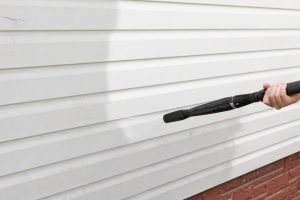Power Washing Tips Before Your Painters Arrive
 Getting long-lasting results from an exterior home painting job greatly depends on the foundation for the application. Before your professional Fort Collins painting contractors arrive, make sure that you have taken the time to thoroughly clean the exterior surfaces of the house including siding, trim, and gutters. Using a pressure washer is one of the most effective ways to remove dirt, dust, and debris, but if it’s not used carefully, you could damage the siding rather than prepare it.
Getting long-lasting results from an exterior home painting job greatly depends on the foundation for the application. Before your professional Fort Collins painting contractors arrive, make sure that you have taken the time to thoroughly clean the exterior surfaces of the house including siding, trim, and gutters. Using a pressure washer is one of the most effective ways to remove dirt, dust, and debris, but if it’s not used carefully, you could damage the siding rather than prepare it.
Why Is a Clean Surface Important?
The key to any good paint job is investing time into preparing the surface. Dirt, dust, debris, cobwebs, and more can build up on the exterior of your house and significantly affect both the results and lifespan of your paint job. Cleaning the siding and trim provides the best opportunity for paint to bond and for a smooth, even application. Taking the time to carefully pressure wash your home, allows you to perform a visual inspection of the siding’s condition and discover damages that have gone unnoticed and should be addressed.
Why Should You Use a Pressure Washer?
Although you can wash your house with a garden hose, it will not be as effective as a pressure washer. A hose will simply rinse off loose dust or dirt, but a pressure washer, with up to 50 times more power, will be a much more effective tool for removing years of gunk and grime.
Tips for Power Washing Your Home
To help you get your house ready for a new coat of exterior paint, here are ten tips to pressure wash your home.
1. Be Careful
Because of the strength of a pressure washer, it is extremely important to be careful and calculated with your movements. A pressure washer that is not used correctly can cause damage to the home such as etched wood or vinyl, stripped paint, or injected water into siding boards and other openings.
2. Safety First
If not used correctly, a pressure washer can be extremely dangerous and cause bodily injury. Pay close attention to the direction of the hose and nozzle because water is released from the hose at a very high pressure and can seriously hurt a person, whether they’re standing nearby or at a distance. At a minimum, you may want to wear safety glasses, gloves, and closed-toed shoes.
3. Protect Nearby Items
To prevent damage to plants, flowers, landscaping, vehicles, AC units, electrical utilities, and other features near the home, cover them with plastic or another appropriate material before you begin spraying. Toys, patio furniture, and other loose items should be cleared from the area and all windows or doors should be closed.
4. Choose the Right Tools
The right machine and attachments can make a difference. You’ll need a machine with a higher flow rate (GPM – gallons per minute) to help you get the job done quicker and more effectively. To best clean a house, use a 25 or 40-degree nozzle tip and consider using a brush attachment for stubborn dirt and grime. If using a cleaning agent, be sure to use a soaping nozzle.
For the highest points of the house, use an extension wand rather than climbing a ladder. Operating a pressure washer from a ladder can be extremely dangerous and an extension wand allows you to clean out of reach and hard to reach areas while standing safely on the ground.
5. Test the Sprayer
Before you spray the front of your house, test your skills on a small section of siding, preferably in the back, sides, or behind landscaping. This will allow you to get a feel for the power behind the nozzle and find a technique that works best without risking major damage to an exposed area.
6. Work in the Right Direction
If you’re using a cleaning solution, make sure to apply the solution working from the bottom up using horizontal passes at a lower pressure.
When spraying water, however, make sure to work your way down from top to bottom. This pushes debris downward instead of spreading it around to other areas and prevents dirty water from affecting clean areas.
7. Don’t Over Saturate
Be careful that you don’t oversaturate the home with water. This not only extends your drying time, but it could also lead to water damage under the siding.
8. Work In Small Sections
Spraying smaller sections at a time will help you to be more efficient and more effective.
9. Give It Plenty of Time to Dry
Paint can’t be applied to a wet surface, so make sure that you allow at least 48 hours for the house to dry. Painters will not be able to paint your house if you didn’t plan for adequate drying time.
10. Hire Professionals
If you’re unsure about how to pressure wash your house before painting, invest in professional service. Professional home painters typically offer power washing at an additional fee, but they have extensive experience in knowing when to power wash, how much drying time is needed, and getting the surface clean and ready for an expert paint job.
Call Colortrends today at (970) 308-2135 for superior residential exterior painting in Fort Collins including preparation, application, and long-lasting results!

